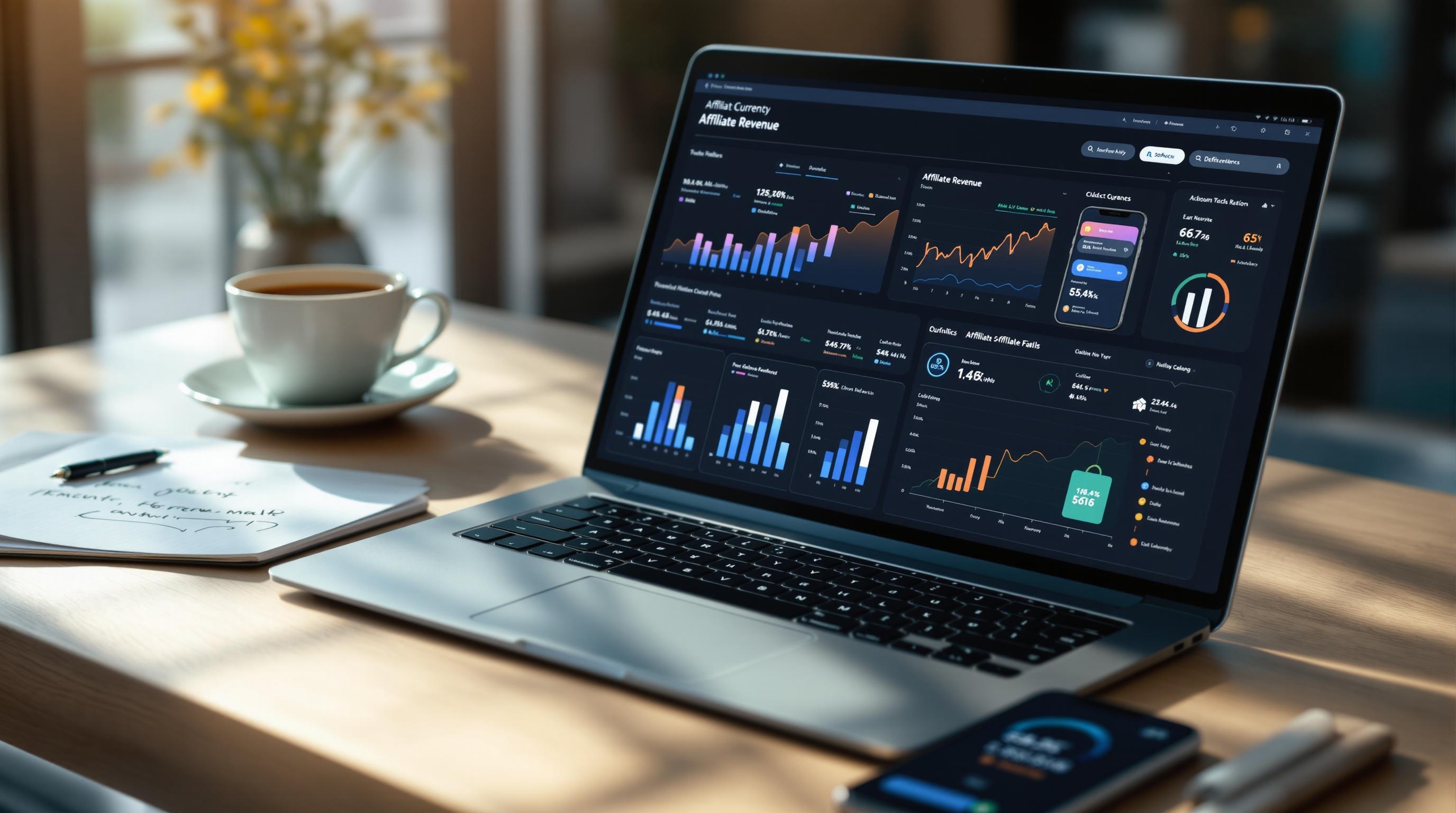
How to Track Digital Currency Affiliate Revenue
Tracking digital currency affiliate revenue can be simplified with the right tools and strategies. Here's what you need to know:
- Why It Matters: Tracking helps optimize campaigns, identify top-performing traffic sources, and manage earnings effectively.
- Tools You Need: Use platforms with real-time reporting, multi-currency support, API integration, and encryption for secure data.
- Key Metrics: Focus on conversion rate, revenue per click (RPC), average order value (AOV), return on ad spend (ROAS), and crypto-adjusted earnings.
- Best Practices: Set up tracking pixels, use UTM parameters, log transactions accurately, and secure your data with encryption and backups.
- Improve Results: Analyze data to refine campaigns, identify high-performing channels, and track long-term growth.
How to Track Affiliate Link Clicks, Revenue & Conversions w ...
Required Tools for Digital Currency Tracking
To expand on your ROI and traffic insights, start by setting up the right tools for tracking digital currency transactions.
Choosing a Tracking Platform
Look for a platform that provides:
- Real-time transaction reporting
- Support for multiple currencies
- API integration for seamless data syncing
- SSL encryption for secure data storage
For example, doublejack.club's affiliate dashboard offers features like up to 75% revenue share, real-time referral tracking, and a clear view of multi-level earnings. The platform you choose will play a key role in analyzing traffic and improving ROI.
Configuring Tracking Software
Once you've selected a platform, you'll need to set it up properly. Key steps include:
- Installing tracking pixels on conversion pages
- Setting up server-to-server postbacks
- Activating crypto payment tracking
- Scheduling automated revenue reports
Setting Up Tracking on WordPress

If you’re using WordPress, you can integrate tracking through:
- Plugins for managing affiliate links
- Configuring URL parameters for tracking
- Adding conversion tracking hooks
- Ensuring transactions are stored securely with encryption
Key Digital Currency Affiliate Metrics
With tracking tools set up, it's time to focus on the numbers that show what's driving your revenue. These key metrics will help you evaluate affiliate performance:
- Conversion Rate: (Number of sales ÷ Number of clicks) × 100
This metric, visible in your affiliate dashboard, tells you how well your traffic is turning into sales. - Revenue per Click (RPC): Total revenue ÷ Number of clicks
Found in your earnings reports, this shows how much revenue each visitor generates on average. - Average Order Value (AOV): Total revenue ÷ Number of transactions
Tracked in your transaction history, this helps you identify which traffic sources or campaigns bring in higher-value customers. - Return on Ad Spend (ROAS): Revenue ÷ Advertising cost
Calculated in campaign analytics, this metric helps you determine which marketing efforts are delivering the best returns. - Crypto-Adjusted Earnings: Earnings adjusted to a base cryptocurrency rate
Displayed in real-time on your dashboard, this accounts for cryptocurrency price changes when calculating revenue.
For affiliates on doublejack.club, these metrics are conveniently available in the platform's dashboard, which supports up to 75% revenue share across multiple referral levels. Use these insights to identify areas for improvement and fine-tune your strategy.
Up next, we’ll dive into how to track and report these data points for better decision-making.
sbb-itb-5e834ae
Digital Currency Revenue Tracking Methods
Once you've identified your key metrics, use these strategies to ensure every digital currency commission is recorded accurately.
Clear Revenue Reporting
Keep detailed records of transaction IDs, commission rates, payment statuses, and timestamps. For example, doublejack.club’s affiliate dashboard provides real-time updates on both pending and confirmed commissions across referral levels. This makes it easier to forecast earnings and verify payments.
Handling Multiple Currencies
When dealing with different types of digital currencies, use these approaches:
- Stablecoins: Record their face value and treat them as a 1:1 equivalent to USD.
- Volatile cryptocurrencies: Log the transaction amounts and apply the daily average exchange rate for accurate tracking.
- Platform tokens: Monitor token balances and convert them based on the current market rate.
Secure Data Management
Protect your revenue data by encrypting stored information and limiting access to only authorized individuals. Set up automated backups and follow data privacy regulations. Regularly audit conversions, check exchange rates, and address any discrepancies to maintain accurate records.
Using Data to Improve Results
Once you’ve set up real-time reporting and secure tracking, it’s time to use that data to fine-tune your strategy and boost revenue.
Identifying Top Traffic Sources
Use custom UTM parameters to tag each channel, then monitor key metrics like conversion rates, revenue per click, and visitor retention. Compare performance across direct referrals, blog posts, videos, and social media to figure out which channels are driving the best results. For example, when promoting doublejack.club, assign unique UTMs for email, social media, and blog links to get a clear picture of what’s working.
With these insights, you can refine your campaigns to focus on the channels delivering the most value.
Enhancing Marketing Campaigns
To get more out of your campaigns and improve ROI, focus on these areas:
- Content performance: Identify which types of content lead to the most engagement and conversions.
- Timing: Pinpoint when conversions peak and schedule your promotions to match those times.
- Device trends: Adapt campaigns based on whether desktop or mobile users are converting better.
Additionally, adjust your messaging and promotions during periods of high crypto market volatility to align with audience behavior.
Tracking Long-Term Growth
Keep an eye on the lifetime value of referred users, including their initial conversion, repeat purchases, and average commissions over time.
For broader growth analysis, look at:
- Network expansion: Assess multi-level referrals and viral growth to see how your network is spreading.
- Historical trends: Review year-over-year data and seasonal patterns to fine-tune future promotions.
Conclusion: Steps for Better Revenue Tracking
Once you've set up your tools and analyzed the metrics, it's time to refine your tracking process with a few critical actions.
Focus on creating a secure and accurate system by leveraging reliable software for real-time crypto pricing and UTM-based conversion tracking.
Here are three steps to improve your revenue tracking:
- Implement encrypted data storage with automated backups to safeguard information.
- Build real-time dashboards to monitor conversions and revenue trends effectively.
- Measure network growth and calculate customer lifetime value for a clearer performance picture.
Consistent monitoring and staying aligned with market shifts are crucial for effective digital currency affiliate tracking. Regularly validate your system to ensure it collects precise revenue data from all channels and conversion points.

